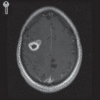Cladophialophora bantiana brain abscess in an immunocompetent patient
- PMID: 23205028
- PMCID: PMC3222763
- DOI: 10.1155/2011/642517
Cladophialophora bantiana brain abscess in an immunocompetent patient
Abstract
Cladophialophora bantiana is a dematiaceous mold with a predilection for causing central nervous system infection, particularly in normal hosts. A case involving a 79-year-old immunocompetent woman who presented with left-sided weakness and a ring-enhancing brain lesion is reported. She underwent surgical excision, which revealed a brain abscess due to C bantiana. The patient was treated with liposomal amphotericin B for several weeks, then switched to voriconazole and flucytosine, but eventually succumbed to the infection. Therapy is not standardized for this rare mycosis, and mortality remains high, even in immunocompetent patients. Additional studies to understand the pathogenesis of this infection and to improve outcomes are needed.
Le Cladophialophora bantiana est une moisissure dématiacée qui a tendance à provoquer une infection du système nerveux central, notamment chez les hôtes en santé. Les auteurs exposent le cas d’une femme immunocompétente de 79 ans qui a consulté en raison d’une faiblesse du côté droit et d’une lésion cérébrale à prise de contraste annulaire. Elle a subi une excision chirurgicale, qui a révélé un abcès cérébral causé par le C bantiana. La patiente a été traitée par amphotéricine B liposomale pendant plusieurs semaines, puis au voriconazole et à la flucytosine, mais a fini par succomber à l’infection. Il n’existe pas de traitement standardisé pour traiter cette mycose rare, et la mortalité demeure élevée, même chez les patients immunocompétents. Des études supplémentaires s’imposent pour comprendre la pathogenèse de cette infection et améliorer les issues.
Keywords: Brain abscess; Cladophialophora bantiana; Flucytosine; Liposomal amphotericin B; Phaeohyphomycosis; Voriconazole.
Figures
References
-
- Revankar SG, Sutton DA, Rinaldi MG. Primary central nervous system phaeohyphomycosis: A review of 101 cases. Clin Infect Dis. 2004;38:206–16. - PubMed
-
- Binford CH, Thompson RK, Gorham ME, et al. Mycotic brain abscess due to Cladosporium trichoides, a new species. Am J Clin Pathol. 1952;22:535–42. - PubMed
-
- Garg N, Devi IB, Vajramani GV, et al. Central nervous system cladosporiosis: An account of ten culture-proven cases. Neurol India. 2007;55:282–8. - PubMed
-
- Revankar SG. Therapy of infections caused by dematiaceous fungi. Expert Rev Anti-Infect Ther. 2005;3:601–12. - PubMed
-
- Fica A, Diaz MC, Luppi M. Unsuccessful treatment with voriconazole of a brain abscess due to Cladophialophora bantiana. Scand J Infect Dis. 2003;35:892–3. - PubMed
Publication types
LinkOut - more resources
Full Text Sources


